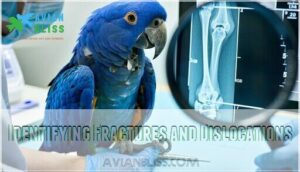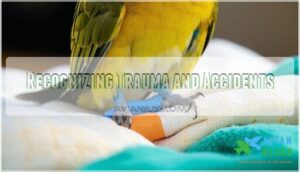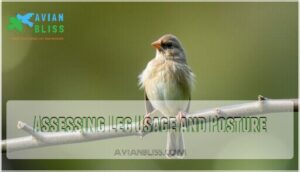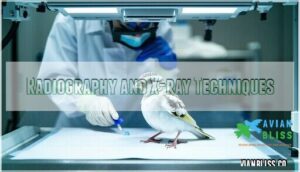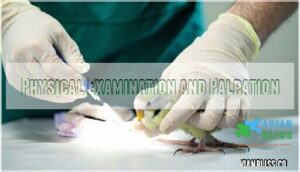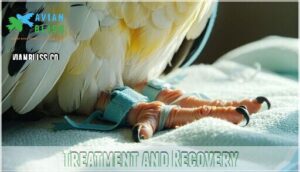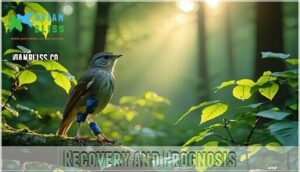This site is supported by our readers. We may earn a commission, at no cost to you, if you purchase through links.
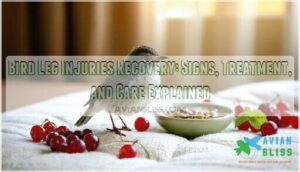 Recovering from bird leg injuries takes patience and careful attention.
Recovering from bird leg injuries takes patience and careful attention.
Watch for signs like limping, swelling, or difficulty perching—these can point to fractures or sprains. A vet may use X-rays or a physical exam to pinpoint the issue.
Treatment often involves splints, bandages, or even surgery for severe cases.
Support your bird’s recovery by creating a calm, stress-free space and guaranteeing proper nutrition with calcium and vitamin D. Monitor movement and behavior closely, as these can indicate how healing is progressing.
While recovery times vary, gentle care can work wonders. Consistency is key to guarantee the best outcomes.
Table Of Contents
- Key Takeaways
- Bird Leg Injury Signs
- Diagnosing Leg Injuries
- Treatment and Recovery
- Rehabilitation and Care
- Recovery and Prognosis
- Frequently Asked Questions (FAQs)
- How long does it take for a bird’s bone to heal?
- Can a bird recover from a broken leg?
- Can a bird recover from a foot injury?
- What to do if a bird has a broken leg?
- What happens after a bird hurts a leg?
- Can a bird’s leg fracture be healed at home?
- Can a bird’s leg heal on its own?
- How to treat an injured bird’s leg?
- Do birds recover from injuries?
- How much does bird leg injury treatment cost?
- Conclusion
Key Takeaways
- Act quickly if your bird shows signs like limping, swelling, or avoiding weight on its leg—early care makes a big difference.
- Keep your bird in a calm environment, confined space with low perches and soft flooring to prevent further injury during recovery.
- Follow your vet’s advice on splinting, surgery, or medication to ensure proper healing and prevent complications.
- Provide proper nutrition with calcium and vitamin D to support bone repair and monitor progress daily for signs of improvement or discomfort.
Bird Leg Injury Signs
When your bird’s leg is injured, you might notice signs like limping, swelling, or difficulty standing.
Paying attention to changes in posture or leg usage is essential for identifying potential fractures or trauma, and this is a complete concept to consider for your bird’s health.
Identifying Fractures and Dislocations
Spotting a bird leg fracture or dislocation requires keen observation. Radiographic views (x-rays) confirm breaks, especially mid-shaft fractures or subluxations.
Palpation techniques help identify swelling or abnormal positioning. Birds may favor their uninjured leg, showing reluctance to move.
A broken bird leg may appear misshapen.
- Weight-bearing avoidance signals trouble.
- Recognizing subluxations guarantees better care.
- Radiography identifies dislocation severity precisely.
Recognizing Trauma and Accidents
When recognizing bird trauma, watch for sudden behaviors like avoiding perches or limping after a perch fall.
Cage hazards, pet attacks, and accidental stepping by humans often cause avian leg injuries. Look closely for swelling or bruising, especially after flight collisions.
Quick action can prevent a minor issue from becoming a serious bird leg fracture or other complications. A key preventative measure involves providing a safe environment to minimize risks, which is a crucial step in preventing avian leg injuries and ensuring the overall well-being of the bird, including the prevention of complications.
Assessing Leg Usage and Posture
When evaluating avian leg injuries, watch for weightbearing changes, gait abnormalities, or balance issues.
A bird avoiding weight on one leg or showing awkward foot position may signal trouble.
Check perch gripping strength—slipping or instability are red flags.
Observing these cues helps gauge leg mobility during bird leg recovery and guarantees timely care for proper healing and improved bird leg mobility.
Diagnosing Leg Injuries
To diagnose leg injuries in birds, you’ll need to focus on both physical signs and behavioral changes.
Tools like X-rays and careful examinations help pinpoint fractures or other issues accurately.
Radiography and X-ray Techniques
Radiography is a key part of avian radiology, helping with fracture identification and bone evaluation.
X-rays demand care and precision from radiologists to guarantee diagnosis accuracy.
- Two radiographic views are essential for clear image interpretation.
- Safe radiation practices protect birds.
- Look for subtle fractures unnoticed by touch.
- Services like Antech Imaging Services assist veterinarians.
- Reliable radiographs guide treatment confidently.
Physical Examination and Palpation
Careful physical examination is essential when diagnosing avian leg injuries.
Palpation techniques help identify fracture palpability, swelling, and joint abnormalities.
Monitor for pain indicators like flinching or withdrawal during touch.
Both hands-on assessments and visual checks aid diagnosis.
A common sign to watch for is favoring one leg, which suggests discomfort.
| Key Focus | What to Check | Why It’s Important |
|---|---|---|
| Fracture Palpability | Bone alignment | Reveals breaks or misalignment. |
| Swelling Assessment | Leg thickness, consistency | Indicates injury severity. |
| Joint Examination | Range of motion | Detects stiffness or dislocation. |
The table outlines key areas of focus for a thorough examination, including joint examination and swelling assessment, to ensure a comprehensive diagnosis.
Observing Behavioral Changes and Symptoms
Birds often hide pain, but subtle signs speak volumes.
Watch for changes that include:
- Activity Reduction: Less movement or limping can signal bird leg injury.
- Appetite Changes: Reduced eating hints at discomfort.
- Feather Changes: Disheveled or fluffed feathers often accompany bird leg pain.
- Vocalization Changes: Softer chirps or silence can reflect stress or bird fracture symptoms.
Quiet observation reveals plenty!
Treatment and Recovery
Treating a bird’s injured leg involves careful stabilization, monitoring, and sometimes surgery to guarantee proper healing. With the right care, you can help your bird regain mobility and prevent complications.
Splinting and Stabilization Methods
When splinting a bird’s leg, start by plucking feathers near the fracture site for regrowth.
Apply hypoallergenic tape directly to the skin, layering splint materials for bird leg support.
Waterproofing techniques, like using stronger outer tape, guarantee durability.
Proper alignment is critical for healing.
A tape splint stabilizes fractures effectively, serving as a non-surgical alternative to a bird leg cast.
Specialized options can be found for bird leg splints.
Surgical Interventions and Options
When fractures won’t heal with splints, surgical options like pinning techniques or external fixation might be needed.
Surgeons stabilize bones, improving recovery odds. Some severe cases require bone grafts, though amputation risks exist for complex breaks.
For avian leg injuries, fracture repair through orthopedic surgery guarantees precise healing. Always focus on proper alignment and detailed post-op care after surgical fractures.
Modern techniques also use microsurgical instruments for precise repairs.
Post-Splinting Care and Management
The road to recovery begins with diligent splint maintenance after your bird’s leg treatment.
Check daily for swelling in the foot and keep the splint clean and dry. Change bandages every 5 days, administer pain medication as prescribed, and create a recovery-friendly environment with low perches and soft flooring.
You can find various bird splint supplies online to aid in the process.
Veterinary rechecks are essential to monitor healing progress during bird fracture rehabilitation.
Rehabilitation and Care
You’ll need to create a calm healing space where your bird can recover without risking further injury to its leg.
During this rehabilitation period, you’ll monitor healing progress while providing proper nutrition that supports bone repair and overall recovery.
Providing a Safe and Calm Environment
Now that treatment is complete, your bird needs a peaceful healing space.
Create a calm environment by placing the cage in a quiet area away from household traffic.
Set up low perches wrapped with non-slip bandages and line the bottom with soft towels to cushion potential falls.
Consider adding comfortable cage accessories to aid in your bird’s recovery.
Cage isolation protects your recovering bird from other pets, while supervised outings can reduce stress without risking further injury to the healing leg.
Monitoring Progress and Adjusting Care
Throughout the healing process, you’ll need to keep a watchful eye on your bird’s recovery.
Regular splint re-evaluation and veterinary followup are essential for ensuring proper healing.
- Check the splint daily for stability, cleanliness, and proper positioning
- Monitor for behavioral changes that might indicate pain or discomfort
- Adjust the environment as your bird gains mobility
Contact your veterinarian immediately if you notice swelling, discharge, or if the splint becomes wet or damaged, which can hinder the recovery.
Maintaining Proper Nutrition and Hydration
While your bird recovers from a leg injury, proper nutrition and hydration become vital healing factors.
Offer fresh water daily in easily accessible dishes that don’t require climbing. Essential nutrients like calcium and vitamin D support bone repair, so consider dietary supplements if recommended by your vet.
To stimulate appetite, present food in new ways—try scatter feeding or different food bowls placed near your bird’s resting area, which can aid in bone repair.
Recovery and Prognosis
You’ll need to understand the recovery timeline and potential outcomes when treating your bird’s leg injury.
The healing process depends on factors like injury severity, treatment timing, and your bird’s overall health condition.
Factors Affecting Recovery and Outcome
Several key factors determine your bird’s leg injury recovery success.
Age and health status substantially impact healing speed, with younger birds typically recovering faster.
Fracture severity directly affects outcomes—clean breaks heal better than complex fractures.
Treatment compliance, including proper splint care and activity restriction, is essential.
Nutritional support enhances healing, while environmental factors like perch adjustments promote proper weight distribution.
Birds with access to sunlight and proper diet typically experience more successful bird leg rehabilitation and fewer complications, which can be influenced by treatment compliance, nutritional support, and fracture severity.
Potential Complications and Risks
While recovery factors influence healing, you should be aware of several risks that can derail your bird’s progress.
Potential complications include:
- Infection risk and septicemia (blood poisoning) from compound fractures
- Malunion fractures when bones heal incorrectly
- Muscle atrophy and reduced mobility from prolonged immobilization
- Bird leg swelling, gangrene, or necrosis from leg bands or hanging injuries
Bandaging can cause abrasions underneath, and untreated fractures occasionally result in death. Watch for symptoms of infection like warmth, redness, or discharge.
Long-Term Care and Management Strategies
While complications can arise during healing, establishing a long-term care plan is key.
Your bird’s ongoing care should focus on gradual rehabilitation and modified housing. Introduce mobility aids like soft perches and implement environmental enrichment to prevent boredom.
Continue with pain management as directed by your avian veterinarian. Preventative measures, including proper perch placement and regular checkups, will safeguard against future injuries.
Bird rehabilitation often requires patience—most feathered patients eventually return to normal behavior with consistent bird leg care. Consider stress management techniques to support their overall well-being.
Frequently Asked Questions (FAQs)
How long does it take for a bird’s bone to heal?
Healing a bird’s bone isn’t a Netflix binge—it takes time.
Typically, small birds’ bones heal in 3-4 weeks, while larger species may take six weeks or more.
Patience, proper care, and rest speed recovery.
Can a bird recover from a broken leg?
Yes, birds can recover from a broken leg with proper care.
Treatment includes splints or surgery, rest, and a stress-free environment.
Quick vet attention, a quiet setup, and regular monitoring guarantee the best results.
Can a bird recover from a foot injury?
A bird can recover from a foot injury with proper care.
Keep the foot clean, apply prescribed treatments, and reduce movement.
Make certain a calm environment, monitor healing daily, and always follow your vet’s advice, which includes keeping the foot clean.
What to do if a bird has a broken leg?
Gently immobilize the bird to prevent further injury, then place it in a quiet, small space.
Stabilize the leg with a temporary splint and seek help from an avian veterinarian as soon as possible.
What happens after a bird hurts a leg?
When a bird injures its leg, it might avoid standing on it, appear weak, or limp.
You should stabilize the leg, limit its movements, and guarantee a calm, quiet environment while seeking veterinary help.
Can a bird’s leg fracture be healed at home?
You can assist with basic care like splinting and creating a safe environment, but complete healing needs vet guidance.
Birds have fragile bones, so professional treatment guarantees proper alignment and prevents complications like infection.
Can a bird’s leg heal on its own?
It’s rare for a bird’s leg to heal completely on its own.
Without proper care, fractures often worsen, leading to chronic pain or mobility issues.
Seek immediate veterinary attention for splinting or stabilization to guarantee recovery.
How to treat an injured bird’s leg?
Keep the bird calm and in a confined space.
Assess for swelling, bleeding, or deformity.
Apply a temporary splint if needed, keep it clean, and contact a vet promptly for proper diagnosis and treatment.
Do birds recover from injuries?
Of course, birds can recover from injuries when treated promptly.
With proper care—like splinting fractures, reducing movement, and providing a quiet space—they heal surprisingly well.
But don’t delay; quick action gives them the best chance!
How much does bird leg injury treatment cost?
Treating a bird’s leg injury can cost $100 to $500, depending on the injury’s severity and treatment type, like splinting or surgery.
Emergency care or specialized procedures may raise costs substantially.
Consult your veterinarian.
Conclusion
Recovering from bird leg injuries may feel like a challenging task, but with patience and care, it’s achievable.
Spotting signs like limping early, seeking professional diagnosis, and following proper treatment—whether splinting or surgery—are essential steps.
Focus on creating a peaceful environment and ensuring your bird gets ample calcium and vitamin D to aid recovery.
Monitor their progress closely, adjusting care if needed, and remember that consistent efforts lead to successful bird leg injuries recovery, ensuring your feathered friend thrives again.

